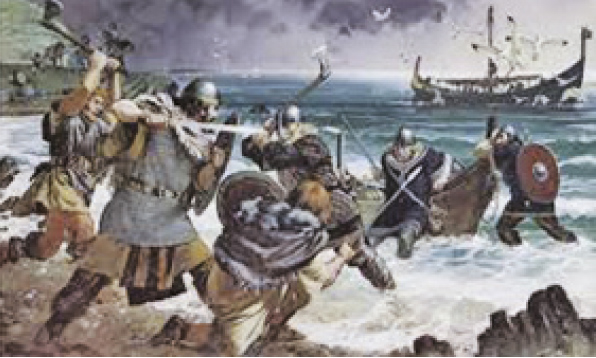
BY Eoin Meegan
This is the season for the macabre, when on dark Halloween nights families gather round the fireside to listen to tales of fiendish deeds and spooky goings-on. They don’t get much more eerie than this, the true story of a strange unearthing in a quiet Donnybrook suburb some 140 years ago.
We have to go back to the year 1879, when some workmen digging a drain in what is now Danesfield, just off Seaview Terrace, came upon what looked like the gruesome contents of an unknown cemetery.
In a circular mound, about one hundred feet in circumference, was a vast interment containing the remains of between 600-700 bodies, many bearing the marks of head injuries that seemed to speak of a violent death, spread out in three layers deep.
The centre piece of this eldritch find was the body of a Scandinavian warrior. He lay supine, with a hole in his skull, and at his feet were two other bodies, female, believed to be sacrificial victims.
The remains of the others were spread out in a kind of mass grave. A sword lay to one side of the warrior, and a spearhead on the other. Also three iron arrowheads, which have not survived, were found in close proximity.
Among the items unearthed in the mass grave were a spindle whorl, part of a bone comb, a loop-headed ring pin, and a bronze pin, 9.5 cm long with an ornate brambled head. Some of these are preserved and shown in the National Museum today.
The excavation and study of the findings was undertaken by Alexander Macalister, Professor of Anatomy and Zoology at Trinity College Dublin, and William Hellier Baily, paleontologist with the Royal Geographical Survey.
What puzzled the authorities at the time was that there had been no record of a burial site on this particular spot. There was no mention of the site in the annals of Dublin, or in any other historical record. The Ordinance Survey records of the 1830s and 40s show no account of this landmark, then known as Mount Erroll, or that it had once been the site of a burial ground.
Initially, it was proposed to seal the mound up, but instead the decision was made to clear the site completely. All the remains were then reinterred in the nearby cemetery at Donnybrook.
What exactly happened at this site? Dr. William Frazer, the leading expert on antiquity at the time, in a paper to the Royal Irish Academy in 1880 concluded that the massacre resulted from an attack on an unsuspecting village by pirate Vikings. The village was wiped out and the pirates fled leaving one of their dead behind. He argued the mass grave and Viking internment were contemporary because the clay type matched in both.
Because of his stature in the archaeological world Frazer’s findings went unquestioned at the time. Recent research has cast doubt on some of his conclusions. Dr. Richard Hall, one of the leading archaeologists of the Viking period, who sadly passed away in 2011, pointed out a number of anomalies in Frazer’s theory.
Firstly, Frazer overlooked the fact that the warrior’s burial was in accordance with Scandinavian tradition, which would certainly not have happened had the native Irish buried the body as he suggests. That leaves the remaining conclusions limited. Either the warrior was inserted into a pre-existing Christian cemetery, a view championed by Irish archaeologist Elizabeth O’Brien, or, as Hall believed, the massacre was a revenge attack on a native settlement carried out by Vikings for the killing of one of their own.
The Viking warrior was then buried by his comrades in Scandinavian fashion, complete with two sacrificial victims, and the villagers in a mass grave beside him.
Hall wrote “several factors combine to indicate that all the occupants of the Donnybrook mound were laid to rest at the same time, and under Scandinavian supervision.”
Firstly, there is the evidence of the consistency of the clay Fraser noted. Secondly, that the mass grave is contained in a mound suggests a non-Christian internment. Lastly, charcoal deposits and mixed animal bones found indicate some kind of funerary pyre, which, combined with the lack of any coffin remains point to it being Viking.
O’Brien, however, argues that the fact that many of the remains on the bottom layer face eastward, a Christian tradition, along with the general orderliness of some internments in the mass grave, suggests otherwise. Her conclusions are that the site was an ancient Christian cemetery into which a Viking burial was later inserted. So mystery still surrounds the find and its origins.
Scholars tend to agree that the two bodies found at the feet of the warrior were probably his wives, or persons of a lower social ranking, who were ritually murdered, a practice which, as evidenced by sites at Oseberg, Birka, and the Isle of Man, was common in the Viking world.
Taking into consideration that after 800 A D personal objects were no longer interred with remains in accordance with Christian practice in Ireland, and matching the artifacts found in the Seaview Terrace grave to similar ones found at Lagore crannog in Co Meath, and other locations between the 7th and 9th centuries, the burial has duly been dated to sometime in the 8th century.
The Scandinavian sword was acquired by Nottingham Castle Museum in the mid 20th century. No one knows what happened to it in the interim. The hilt, inlaid with intricate engravings survives in two pieces with the grip missing, and 54cm of blade still intact.
The authenticity of the sword was verified by Dr. Hall who notes “The Donnybrook sword ranks amongst the finest products of Viking-age weaponry yet discovered in the British Isles.”
In 1885 the site was listed in Thom’s Directory as Danesfield, probably because of the Viking connection. Prior to that it had been known as Mount Erroll. Seaview Terrace itself had only been in existence some 40 years earlier, when John Semple built six Georgian-style houses there in the 1830s. The name was appropriate back then because one could (just about) catch a glimpse of the sea.
Today Danesfield, the spot where the ghoulish find came to light, is the home of the German Ambassador’s residence. Seaview Terrace is a quiet residential area off Ailesbury Road.
It has been home to many well-known people down the years, including the Jameson family, famous whiskey makers. Senator Maurice Moore, brother of George Moore, lived in no 5, and novelist Anthony Trollope resided at no 6 from 1855 until 1859.
Legend has it that the ghost of Trollope haunts the avenue, and can frequently be seen on dark wintry nights. Or might there be another explanation? Perhaps the spectre people claimed to have seen was that of an ancient Dane looking for his home and long-dead comrades.
Whatever the facts, a site that once unearthed a shocking and unsettling discovery all those years ago has, thankfully, returned to a place of tranquillity and peace.
Sources:
Hall, R. A. ‘A Viking-age Grave at Donnybrook, Co. Dublin’. Journal of Medieval Archaeology, Vol. 22. 1978.
O’Brien, E. ‘A Re-assessment of the ‘Great Sepulchral Mound’ containing a Viking burial at Donnybrook, Dublin’. Society of Medieval Archaeology, Vol. 36. 1992.



